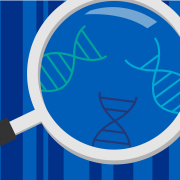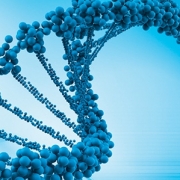Endometriosis and ovarian cancer: A genetic link
A new study aims to unravel the genomic connection between these two different health conditions
Recent research has suggested that genetic variants known to increase a person’s risk of endometriosis may also increase their chances of developing ovarian cancer.
Below, we explore both conditions and their genomic underpinning to better understand the findings from the study.
What is endometriosis?
Endometriosis is a long-term gynaecological condition where the tissue that forms the uterus lining (called the endometrium) grows in other locations, such as the ovaries, fallopian tubes or even outside the reproductive system entirely. The endometrium includes the part of the uterus lining that thickens in preparation for a fertilised egg to implant, and is shed during menstruation when implantation does not occur.
While endometriosis is not a type of cancer, they do share several characteristics, including the metastasis-like behaviour of cells travelling to other locations in the body, where they proliferate and can invade other tissues. Like tumours, endometrial lesions cause the growth of new blood vessels to supply their cells’ requirements and the cells live longer by avoiding programmed cell death.
Symptoms of endometriosis can include pain in the lower abdomen or back, heavy periods and fertility problems. It affects approximately 1 in 10 women, and can cause symptoms that have a major impact on quality of life.
Endometriosis can run in families indicating that its cause can be genetic, but may also be influenced by other factors.
Understanding ovarian cancer
Ovarian cancers are rare and the deadliest type of gynaecological cancer, in part because they often go undiagnosed until the disease has progressed to a point where treatment is less effective. They are hard to detect because they have few symptoms in the early stages and no straightforward screening programmes are available.
There are several different types of ovarian cancers, but epithelial ovarian cancers (EOCs), which originate in the cells covering the ovaries, are the most common.
Ovarian cancer risk is known to be increased by variants in the BRCA1 and BRCA2 genes, and a handful of other gene variants that cause Lynch syndrome. These gene variants are uncommon, however, affecting 1 in 300-500 people, whereas 1 in 76 people will develop ovarian cancer.
Observational studies have shown that women with endometriosis make up a disproportionate percentage of ovarian cancer patients, but the cause of this correlation was not understood.
Finding the link
New research published in Cell Reports Medicine compared the genomes of 15,000 endometriosis patients with genomes from 25,000 ovarian cancer patients to look for regions of DNA that increase the risk of both conditions.
They were able to identify that genetic predisposition to endometriosis increased the risk of EOC, rather than the other way around. The link was strongest between endometriosis and three subtypes of EOC: clear cell ovarian cancer, endometrioid ovarian cancer and high-grade serous ovarian cancer.
The authors stressed that their findings should not be cause for alarm as the overall risk of ovarian cancer is still low for women with endometriosis, with only 1 in 55 being affected by both conditions.
Looking to the future, the study identified genes that could be evaluated as potential drug targets and help in the development of screening to identify people at the greatest risk of developing ovarian cancer.
–









